
Orb-weaver spiders are members of the spider family Araneidae. They are the most common group of builders of spiral wheel-shaped webs often found in gardens, fields and forest. "Orb" can in English mean "circular", hence the English name of the group. Araneids have eight similar eyes, hairy or spiny legs, and no stridulating organs.

The spider species Araneus diadematus is commonly called the European garden spider, diadem spider, orangie, cross spider and crowned orb weaver. It is sometimes called the pumpkin spider, although this name is also used for a different species, Araneus marmoreus. It is an orb-weaver spider found in Europe and North America.

Austracantha is a genus of spider with a single species, Austracantha minax, commonly known as the jewel spider or the Christmas spider. It is a member of the family Araneidae and is endemic to Australia. They are relatively small spiders, reaching a maximum total body length of only around 12 mm (0.47 in) for females, and 5 mm (0.20 in) for males. Their abdomen has six distinctive projections ("spines") that makes them easy to identify. They are predominantly a shiny black, with variable white, yellow, and orange patterns. Melanistic forms also occur during autumn. They are facultatively gregarious, and can be found in large aggregations of overlapping orb webs. They feed on small flying insects that get entangled in their webs. They are harmless to humans, though the webs can be a nuisance for bushwalkers. They are most abundant during the summer months.

Eriophora is a genus of orb-weaver spiders first described by Eugène Simon in 1895. It occurs in the Americas, Australasia, and Africa. The name is derived from Ancient Greek roots, and means "wool bearing".

Argiope keyserlingi is a species of orb-web spider found on the east coast of Australia, from central New South Wales to northern Queensland. It is very similar in appearance to a closely related North-Queensland species, Argiope aetherea. A. keyserlingi is commonly found in large populations in suburban parks and gardens, particularly among the leaves of the Lomandra longifolia. Like many species of orb-web spider, A. keyserlingi shows considerable sexual size dimorphism, as the females are many times larger than the males. Mature females can be seen during the summer months and it is not uncommon to see multiple males on the web of one female.

Argiope mascordi is a species of orb-web spider found in Queensland, Australia. The females of this species are smaller and less colourful than many other spiders in the genus Argiope. Males are larger than many other Argiope. Web decorations in this species are interesting in that A. mascordi juveniles construct a cross and adults construct a disc. The reason for this apparent reversal in decorating behaviour remains unknown.

Ordgarius is a genus of orb-weaver spiders first described by Eugen von Keyserling in 1886. Adult females of the genus are bolas spiders, capturing their prey with one or more sticky drops at the end of a single line of silk rather than in a web. Males and juvenile females capture their prey directly with their legs.
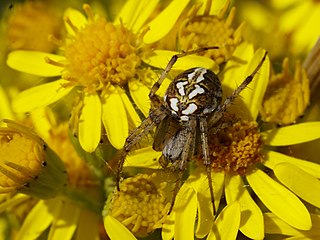
Neoscona, known as spotted orb-weavers and barn spiders, is a genus of orb-weaver spiders (Araneidae) first described by Eugène Simon in 1895 to separate these from other araneids in the now obsolete genus Epeira. The name Neoscona was derived from the Greek νέω, meaning "spin", and σχοῐνος, meaning "reed" They have a mostly pantropical distribution and one species, Neoscona adianta, has a palearctic distribution. As of April 2019 there are eight species that can be found in the United States and Canada:
Bertrana is a genus of Central and South American orb-weaver spiders first described by Eugen von Keyserling in 1884. It includes some of the smallest known araneid orb-weavers. Bertrana striolata females are 4.5 mm long or less. The eight eyes are in two rows. The abdomen is white on top and on the sides, with multiple hieroglyphic-like lines and bars of many different shapes and length. In females, these are red, in males, black.
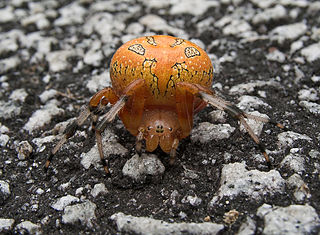
Araneus marmoreus, commonly called the marbled orb-weaver, is a species of spider belonging to the family Araneidae. It is sometimes also called the pumpkin spider from the resemblance of the female's inflated abdomen to an orange pumpkin. It has a Holarctic distribution.

Plebs bradleyi, synonym Araneus bradleyi, is a spider in the orb-weaver family Araneidae. Known as the enamelled spider, it is a common Australian spider. It occurs in Tasmania, New South Wales, Queensland and Victoria.

Argiope catenulata, also known as the grass cross spider, is a species of orb-weaver spiders ranging from India to the Philippines and Papua New Guinea, and also found in Australia in 2019. Like other species of the same genus, it builds a web with a zig-zag stabilimentum.

Neoscona domiciliorum, commonly known as the spotted orbweaver or redfemured spotted orbweaver, is a spider in the family Araneidae. The specific epithet domiciliorum means "of dwellings" in Latin and refers to the fact that this species is often found living on buildings. Their bites are not known to cause serious harm in humans.
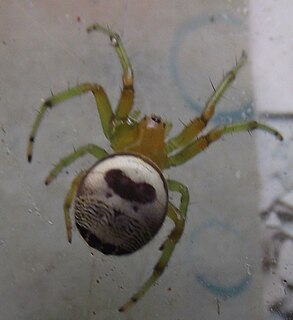
Araneus mitificus, commonly known as the kidney garden spider or pale orb weaver, is a species of orb-weaver spider found in South, East, and Southeast Asia.

Plebs is a genus of orb-weaver spiders first described by M. M. Joseph & V. W. Framenau in 2012. Though many of its species have been moved around, a 2012 taxonomic revision suggested that these spiders comprise a monophyletic genus of closely related spiders that evolved in Australia and, through subsequent movements, spread into parts of Asia and Pacific islands.
Carepalxis is a genus of orb-weaver spiders first described by Ludwig Carl Christian Koch in 1872. These spiders only build webs at night and break them down in the morning. C. coronata builds orb webs up to 60 centimetres (24 in) in diameter with closely woven spiral threads.
Heurodes was a genus of orb-weaver spiders first described by Eugen von Keyserling in 1886. It previously contained three species, Heurodes fratrellus and Heurodes turritus, both now considered nomen dubium, and Heurodes porcula, now considered a synonym of Eriovixia porcula(Simon, 1877)
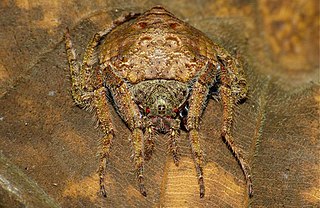
Dolophones conifera, known as the wrap-around spider, is a species of spider in the family Araneidae indigenous to Australia. It is named for its ability to flatten and wrap its body around tree limbs as camouflage. It is found in Western Australia along with several other species from the genus Dolophones, and was first described in 1886.
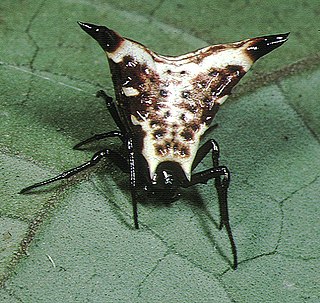
Micrathena lucasi is a spider in the orb-weaver spider family, Araneidae. The species belongs to genus Micrathena and was first named in 1864 by Eugen von Keyserling.
Ordgarius monstrosus is a species of spider in the orb-weaver spider family Araneidae, found in Queensland, Australia. O. monstrosus is a bolas spider. Rather than using a web, adult females catch their prey by using a line with one or two sticky drops which they swing.

















